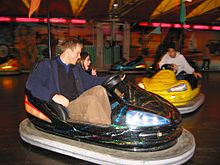Bumper cars: Difference between revisions
No edit summary |
→External links: adding an external link |
||
| Line 32: | Line 32: | ||
==External links== |
==External links== |
||
* [http://www.funfairevents.com] Evans Leisure |
|||
* [http://www.lusseautoscooters.com/thebeach.html History of bumper cars - Dodgem and others] |
* [http://www.lusseautoscooters.com/thebeach.html History of bumper cars - Dodgem and others] |
||
* [http://www.majesticrides.com Majestic Manufacturing Inc.Bumper Car Manufacturer] |
* [http://www.majesticrides.com Majestic Manufacturing Inc.Bumper Car Manufacturer] |
||
Revision as of 12:14, 27 April 2009

Bumper car is the generic name for a type of flat ride consisting of several small electric cars which draw power from the floor and/or ceiling, and which are turned off by the operator at the end of a session. They are also known as dodgem cars, or simply dodgems, the last name being the usual term in British English.
The Inventor was William Thurston who was part of the Thursten carnival attraction
Power is commonly supplied through one of two methods:
- The oldest and most common method uses a conductive floor and ceiling, each with a separate power polarity. Contacts under the vehicle touch the floor while a pole mounted contact touches the ceiling, forming a complete circuit.
- A newer method uses alternating strips of metal across the floor separated by insulating spacers, and no ceiling grid. The alternating strips carry the supply current, and the bumper cars are large enough so that the vehicle body can always cover at least two strips at any one time. An array of brushes under the car make random contact with whatever strip is below, and the voltage polarity on each contact is sorted out to always provide a correct and complete circuit to operate the vehicle.
The metal floor is usually set up as a rectangular or oval track, and graphite is sprinkled on the floor to decrease friction.[citation needed] A rubber bumper surrounds each vehicle, and drivers ram each other as they travel. The controls are usually an accelerator and a steering wheel. The car can be made to go backwards by turning the steering wheel far enough in either direction, necessary in the frequent pile-ups that occur. Most carnivals and amusement parks require riders to be at least 42 inches or taller to ride and 52 inches (1.3 m) or taller to drive the cars.[citation needed]
Although the idea of the ride is to bump other cars, safety-conscious (or at least litigation-conscious) owners often put up signs reading "This way round" and "No bumping". Depending on the level of enforcement by operators, they are usually ignored by bumper car riders, especially younger children.
During their heyday (late 1920s through 1950s), the two major bumper car brands were Dodgem and the Lusse Brothers' Auto-Skooter. In the mid 1960s, Disneyland introduced hovercraft-based bumper cars called "The Flying Saucers," which worked on the same principle as an air hockey game; the ride was a mechanical failure and closed after a few years.
The current largest bumper car floor is located at Six Flags Great America in Gurnee IL, and is called the Rue Le Dodge (Rue Le Morgue during October for Fright Fest). The ride is 51 feet (16 m), 9 inches by 124 feet 9 inches (38.02 m) or a total of 6,455 square feet (599.7 m2). An exact replica of the ride was built at California's Great America in Santa Clara CA, however in 2005 became a one way bumper car floor (as many have) adding a concrete island in the middle of the floor to promote the one way traffic. This made Rue Le Dodge at Six Flags Great America the largest floor.
See also
Gallery
-
Painting of Bumper Cars
-
Bumper Cars at "Taunuswunderland"
-
Bumper Car at Frankfurt
-
A group of youngsters having fun with the bumper cars.
-
A guy driving a bumper car in Angeles City.
External links
- [1] Evans Leisure
- History of bumper cars - Dodgem and others
- Majestic Manufacturing Inc.Bumper Car Manufacturer
- Bertazzon 3B Srl. - Bumper Car Manufacturer
- Car Games site where you can play free bumper car games





